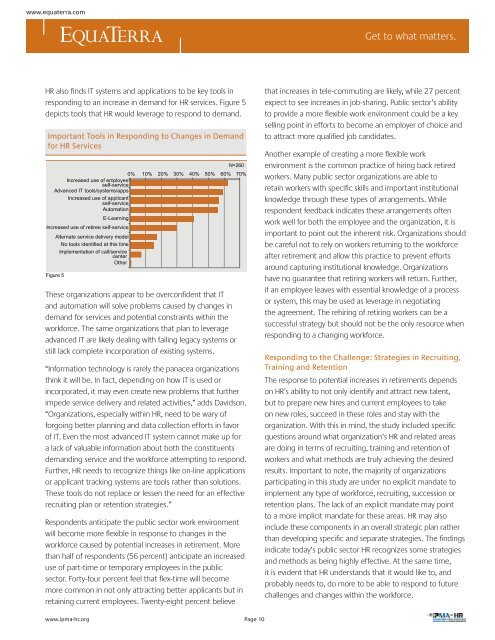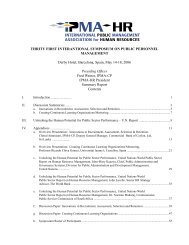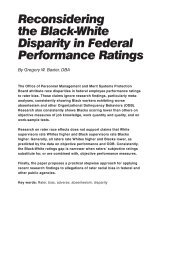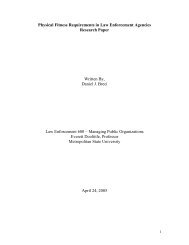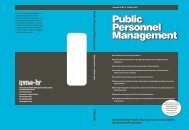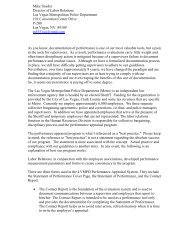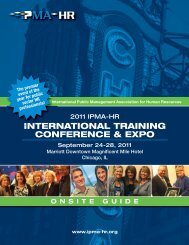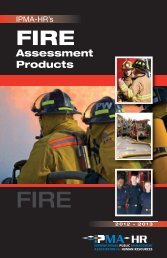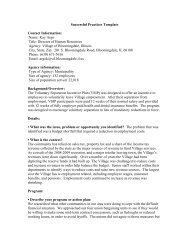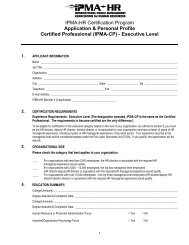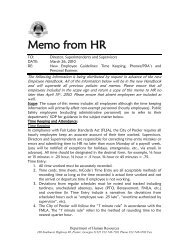The Impact of the Aging Workforce on Public Sector Organizations ...
The Impact of the Aging Workforce on Public Sector Organizations ...
The Impact of the Aging Workforce on Public Sector Organizations ...
Create successful ePaper yourself
Turn your PDF publications into a flip-book with our unique Google optimized e-Paper software.
www.equaterra.comGet to what matters.HR also fi nds IT systems and applicati<strong>on</strong>s to be key tools inresp<strong>on</strong>ding to an increase in demand for HR services. Figure 5depicts tools that HR would leverage to resp<strong>on</strong>d to demand.Important Tools in Resp<strong>on</strong>ding to Changes in Demandfor HR Services<str<strong>on</strong>g>The</str<strong>on</strong>g>se organizati<strong>on</strong>s appear to be overc<strong>on</strong>fi dent that ITand automati<strong>on</strong> will solve problems caused by changes indemand for services and potential c<strong>on</strong>straints within <str<strong>on</strong>g>the</str<strong>on</strong>g>workforce. <str<strong>on</strong>g>The</str<strong>on</strong>g> same organizati<strong>on</strong>s that plan to leverageadvanced IT are likely dealing with failing legacy systems orstill lack complete incorporati<strong>on</strong> <str<strong>on</strong>g>of</str<strong>on</strong>g> existing systems.N=2600% 10% 20% 30% 40% 50% 60% 70%Increased use <str<strong>on</strong>g>of</str<strong>on</strong>g> employeeself-serviceAdvanced IT tools/systems/appsIncreased use <str<strong>on</strong>g>of</str<strong>on</strong>g> applicantself-serviceAutomati<strong>on</strong>E-LearningIncreased use <str<strong>on</strong>g>of</str<strong>on</strong>g> retiree self-serviceAlternate service delivery modelNo tools identified at this timeImplementati<strong>on</strong> <str<strong>on</strong>g>of</str<strong>on</strong>g> call/servicecenterO<str<strong>on</strong>g>the</str<strong>on</strong>g>rFigure 5“Informati<strong>on</strong> technology is rarely <str<strong>on</strong>g>the</str<strong>on</strong>g> panacea organizati<strong>on</strong>sthink it will be. In fact, depending <strong>on</strong> how IT is used orincorporated, it may even create new problems that fur<str<strong>on</strong>g>the</str<strong>on</strong>g>rimpede service delivery and related activities,” adds Davids<strong>on</strong>.“Organizati<strong>on</strong>s, especially within HR, need to be wary <str<strong>on</strong>g>of</str<strong>on</strong>g>forgoing better planning and data collecti<strong>on</strong> efforts in favor<str<strong>on</strong>g>of</str<strong>on</strong>g> IT. Even <str<strong>on</strong>g>the</str<strong>on</strong>g> most advanced IT system cannot make up fora lack <str<strong>on</strong>g>of</str<strong>on</strong>g> valuable informati<strong>on</strong> about both <str<strong>on</strong>g>the</str<strong>on</strong>g> c<strong>on</strong>stituentsdemanding service and <str<strong>on</strong>g>the</str<strong>on</strong>g> workforce attempting to resp<strong>on</strong>d.Fur<str<strong>on</strong>g>the</str<strong>on</strong>g>r, HR needs to recognize things like <strong>on</strong>-line applicati<strong>on</strong>sor applicant tracking systems are tools ra<str<strong>on</strong>g>the</str<strong>on</strong>g>r than soluti<strong>on</strong>s.<str<strong>on</strong>g>The</str<strong>on</strong>g>se tools do not replace or lessen <str<strong>on</strong>g>the</str<strong>on</strong>g> need for an effectiverecruiting plan or retenti<strong>on</strong> strategies.”Resp<strong>on</strong>dents anticipate <str<strong>on</strong>g>the</str<strong>on</strong>g> public sector work envir<strong>on</strong>mentwill become more fl exible in resp<strong>on</strong>se to changes in <str<strong>on</strong>g>the</str<strong>on</strong>g>workforce caused by potential increases in retirement. Morethan half <str<strong>on</strong>g>of</str<strong>on</strong>g> resp<strong>on</strong>dents (56 percent) anticipate an increaseduse <str<strong>on</strong>g>of</str<strong>on</strong>g> part-time or temporary employees in <str<strong>on</strong>g>the</str<strong>on</strong>g> publicsector. Forty-four percent feel that fl ex-time will becomemore comm<strong>on</strong> in not <strong>on</strong>ly attracting better applicants but inretaining current employees. Twenty-eight percent believethat increases in tele-commuting are likely, while 27 percentexpect to see increases in job-sharing. <strong>Public</strong> sector’s abilityto provide a more fl exible work envir<strong>on</strong>ment could be a keyselling point in efforts to become an employer <str<strong>on</strong>g>of</str<strong>on</strong>g> choice andto attract more qualifi ed job candidates.Ano<str<strong>on</strong>g>the</str<strong>on</strong>g>r example <str<strong>on</strong>g>of</str<strong>on</strong>g> creating a more fl exible workenvir<strong>on</strong>ment is <str<strong>on</strong>g>the</str<strong>on</strong>g> comm<strong>on</strong> practice <str<strong>on</strong>g>of</str<strong>on</strong>g> hiring back retiredworkers. Many public sector organizati<strong>on</strong>s are able toretain workers with specifi c skills and important instituti<strong>on</strong>alknowledge through <str<strong>on</strong>g>the</str<strong>on</strong>g>se types <str<strong>on</strong>g>of</str<strong>on</strong>g> arrangements. Whileresp<strong>on</strong>dent feedback indicates <str<strong>on</strong>g>the</str<strong>on</strong>g>se arrangements <str<strong>on</strong>g>of</str<strong>on</strong>g>tenwork well for both <str<strong>on</strong>g>the</str<strong>on</strong>g> employee and <str<strong>on</strong>g>the</str<strong>on</strong>g> organizati<strong>on</strong>, it isimportant to point out <str<strong>on</strong>g>the</str<strong>on</strong>g> inherent risk. Organizati<strong>on</strong>s shouldbe careful not to rely <strong>on</strong> workers returning to <str<strong>on</strong>g>the</str<strong>on</strong>g> workforceafter retirement and allow this practice to prevent effortsaround capturing instituti<strong>on</strong>al knowledge. Organizati<strong>on</strong>shave no guarantee that retiring workers will return. Fur<str<strong>on</strong>g>the</str<strong>on</strong>g>r,if an employee leaves with essential knowledge <str<strong>on</strong>g>of</str<strong>on</strong>g> a processor system, this may be used as leverage in negotiating<str<strong>on</strong>g>the</str<strong>on</strong>g> agreement. <str<strong>on</strong>g>The</str<strong>on</strong>g> rehiring <str<strong>on</strong>g>of</str<strong>on</strong>g> retiring workers can be asuccessful strategy but should not be <str<strong>on</strong>g>the</str<strong>on</strong>g> <strong>on</strong>ly resource whenresp<strong>on</strong>ding to a changing workforce.Resp<strong>on</strong>ding to <str<strong>on</strong>g>the</str<strong>on</strong>g> Challenge: Strategies in Recruiting,Training and Retenti<strong>on</strong><str<strong>on</strong>g>The</str<strong>on</strong>g> resp<strong>on</strong>se to potential increases in retirements depends<strong>on</strong> HR’s ability to not <strong>on</strong>ly identify and attract new talent,but to prepare new hires and current employees to take<strong>on</strong> new roles, succeed in <str<strong>on</strong>g>the</str<strong>on</strong>g>se roles and stay with <str<strong>on</strong>g>the</str<strong>on</strong>g>organizati<strong>on</strong>. With this in mind, <str<strong>on</strong>g>the</str<strong>on</strong>g> study included specifi cquesti<strong>on</strong>s around what organizati<strong>on</strong>’s HR and related areasare doing in terms <str<strong>on</strong>g>of</str<strong>on</strong>g> recruiting, training and retenti<strong>on</strong> <str<strong>on</strong>g>of</str<strong>on</strong>g>workers and what methods are truly achieving <str<strong>on</strong>g>the</str<strong>on</strong>g> desiredresults. Important to note, <str<strong>on</strong>g>the</str<strong>on</strong>g> majority <str<strong>on</strong>g>of</str<strong>on</strong>g> organizati<strong>on</strong>sparticipating in this study are under no explicit mandate toimplement any type <str<strong>on</strong>g>of</str<strong>on</strong>g> workforce, recruiting, successi<strong>on</strong> orretenti<strong>on</strong> plans. <str<strong>on</strong>g>The</str<strong>on</strong>g> lack <str<strong>on</strong>g>of</str<strong>on</strong>g> an explicit mandate may pointto a more implicit mandate for <str<strong>on</strong>g>the</str<strong>on</strong>g>se areas. HR may alsoinclude <str<strong>on</strong>g>the</str<strong>on</strong>g>se comp<strong>on</strong>ents in an overall strategic plan ra<str<strong>on</strong>g>the</str<strong>on</strong>g>rthan developing specifi c and separate strategies. <str<strong>on</strong>g>The</str<strong>on</strong>g> fi ndingsindicate today’s public sector HR recognizes some strategiesand methods as being highly effective. At <str<strong>on</strong>g>the</str<strong>on</strong>g> same time,it is evident that HR understands that it would like to, andprobably needs to, do more to be able to resp<strong>on</strong>d to futurechallenges and changes within <str<strong>on</strong>g>the</str<strong>on</strong>g> workforce.www.ipma-hr.orgPage 10


